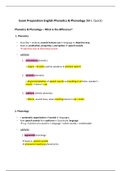Exam Preparation English Phonetics & Phonology (Mrs. Quick)
Phonetics & Phonology – What is the difference?
1. Phonetics
o describes + analyses sounds humans use in language in objective way,
o deals w. production, properties + perception of speech sounds
→ objective way of describing sounds
o subfields:
1. articulatory phonetics
= organs + muscles used by speakers to produce speech
2. acoustic phonetics
= physical properties of speech sounds as travelling in air betw. speaker’s
mouth + listener’s ear
3. auditory (Gehör) phonetics
= effects, sounds have, when reaching listener’s ear + brain
2. Phonology
o = systematic organization of sounds in languages,
o how speech sounds form patterns in 1 particular language
→ e.g.: function of a sound in 1 language + which sounds = combineable
o subfields:
1. segmental phonology
→ deals w. speech sounds
→ phonemic inventory/phonotactics
,2. suprasegmental phonology
= concerned w. larger units: syllables, words + IP’s
→ stress/rhythm
→ intonation ("pitch contour"/"pitch movement")
Minimal Pairs
o minimal pairs = 2 words w. exact same number of sounds, ONLY 1 different
→ changes meaning
→ e.g. sɪk - θɪk (sick – thick)
vs. θɪk–θi:m (thick – theme) same number of sounds, but: NOT only 1 different
Phones, Phonemes & Allophones
o phones = (actual) speech sounds
→ e.g. [f], [v], [iː], [t], [th], [l], [ɫ]
o phonemes = abstractions over speech sounds
→ = smallest linguistic unit distinguishing forms w. different meanings
→ e.g. /f/, /v/, /iː/, /t/, /l/
o allophone = 1 of several phonetic realisations of a phoneme
→ [l] + [ɫ] = allophones of phoneme /l/
Allophones (Phonemvarianten)
= different realizations of a phoneme (Phonemvarianten)
→ e.g. English plural:
/s/ (phoneme) → [s], [z], [ɪz] (allophones)
hat, bags, faces → hæts, bægz, feɪsɪz
, o Complementary distribution (komplementäre Verteilung)
= allophones occur exclusively in 1 specific phonetic context
→ there’s a rule when which allophone = used
e.g.
o same phoneme: /r/
o different allophones: [ɹ] & [ɹ]̥
→ [ɹ]: AFTER VL consonants, e.g. trip
→ [ɹ]: in all other contexts, e.g. wrap
→ phonological rules, e.g. aspiration:
• plosive [– voice] : /p,t,k/ → aspirated / #__ [V] (= @ word beginning)
• plosive [– voice] : /p,t,k/ → unaspirated / elsewhere
e.g. Peter Parker
Spider Man
→ predictable distribution
o Free variation
= typical f. dialects
→ e.g. vase: /vaːz/ /vɔːz/ /veɪz/
→ some words: > 1 pronunciaton
e.g.
variation of German: ʁ, R, ɹ
→ Zungenspitzen /r/ vs. Zäpfchen /r/
Allophonic variation
o allophones = different phoneme realizations (pronunciations)
→ NO meaning change!
o in contrast to phonemes:
◦ NO minimal pair contrast
◦ phonetic similarity
o enclosed in […] → concrete utterance





